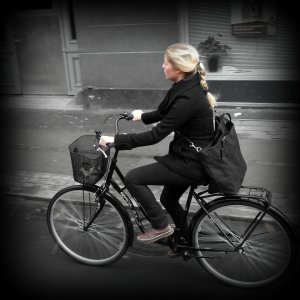Jennifer Worth, Jessica Fletcher, MJ
Riding a bicycle used to be thought of as kids play, a way for youth to get to school, or  something an adult did for exercise. That attitude is changing. More and more people use bikes to get from point A to point B and beyond.
something an adult did for exercise. That attitude is changing. More and more people use bikes to get from point A to point B and beyond.
Jennifer Worth, whose memoirs are brought to life in the BCC show Call the Midwife, shows us that it wasn’t that long ago professional women road bikes to do their job. With her box of supplies strapped to the back, and in a skirt, the midwives and nuns would ride their bikes to check on the women  of the East End of London.
of the East End of London.
Jessica Fletcher, the beloved fictional character from Murder She Wrote, rides her bike all over her small town of Cabot Cove – from murder scene to murder scene. There’s no end to where a bicycle can take you.
An my friend MJ and her family will ride their bikes to her sons school, 20 miles away, or into the city nearest her, about 35 miles away, just for the fun of it or to attend an event. It is a common occurrence for her to ride her bike to the farmers market and come home with her basket and panniers filled with fresh produce and other goodies.
I don’t know the official name I call them market bikes or cruisers – bikes with comfortable seats, handlebars you don’t have to hunch over to reach, and a basket or two. They are useful for jaunts around the neighborhood or to your local market or to take you to a community event. You don’t have to worry about finding a parking space, if there isn’t a bike rack use a handy poll. There is something freeing about getting to your destination and back under the power of your pedal.
Where do you like to ride your bike to? Do you ride for utility or exercise?
Remember you helmet
You can link to MJ’s amazing blog Imaginary Bicycle here: http://imaginarybicycle.blogspot.com/





 Most everything else can be recycled. Check with your local waste management company
Most everything else can be recycled. Check with your local waste management company